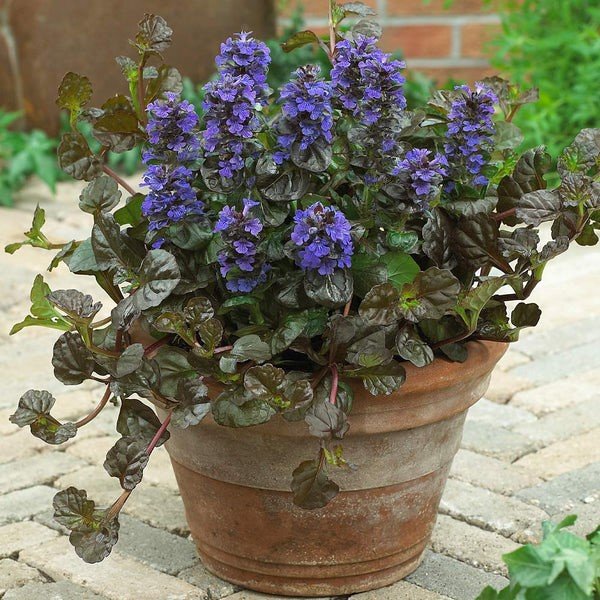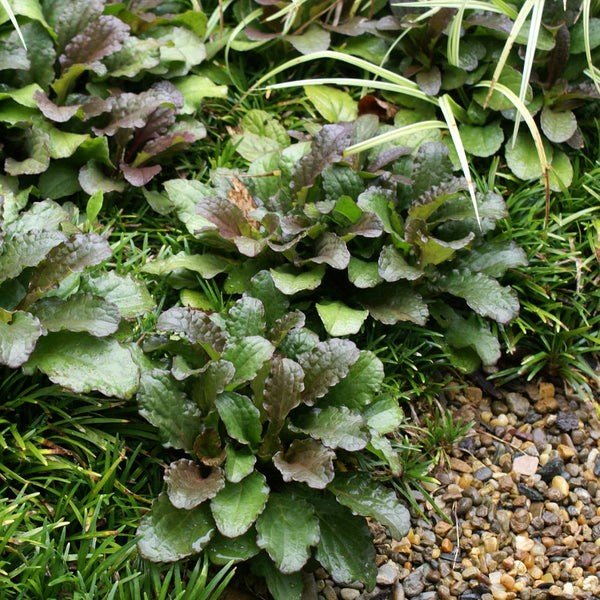Ajuga Chocolate Chip Ajuga Reptans 'Valfredda'
Ajuga Chocolate Chip Ajuga Reptans 'Valfredda'
Monthly Theme: Gorgeous Ground Covers!
Are you tired of mowing that steep incline or narrow pathway? Does your yard have way too much grass? Instead of another bag of mulch under the Maple tree, how about a beautiful carpet of color from a hardy ground cover? Are you fed up with weed-whacking the grass under the fence or do you just want to reduce the time spent weeding? Wouldn’t it be nice to fill in that dirt between the stepping-stones with a vibrant ground cover? Let’s talk about ground covers this month and open up your options for new and decorative vegetation in your yard.
Luckily, there are all kinds of ground covers to choose from. If you have a rock or herb garden, Sweet Woodruff (Galium odoratum) fills in quickly and offers a fragrant amora in the air. It has star-like white flowers dancing on top of spiraled bright green leaves. It blooms during May and June. Sweet woodruff prefers part to full shade, moist, but well-drained soil. It grows eight inches tall and naturalizes rapidly. It’s great beneath shrubs.
Creeping thyme (Thymus praecox) will bring fragrant foliage and flowers. It’s great for rock gardens, poor soil, and drought. Creeping Thyme are covered with purple or white flowers in late spring, which makes perfect for pollinators. It spreads rapidly, thrives in full sun, grows in poor soil, and is drought tolerant. As a bonus, you can snip off the leaves for cooking!
Creeping Juniper (Juniperus horizontalis) works wells by banks and sloping areas and can handle poor soil conditions. The best part is that junipers make a dense mat that weeds can’t penetrate. It prefers full sun.
Some people swear by Periwinkle (Vinca minor). It does spread rapidly and has a petite purple flower, but it’s poisonous to dogs and cats. Plus, once it gets a foothold, it’s hard to pull out.
There are many low-growing varieties of sedum, which make easy to maintain ground covers. Its fleshy leaves hold water in order to survive dry spells, but they do need full sun. Some have small flowers, but the main focus is the colorful foliage.
My Grandma Ziesman had an entire bed of Japanese Pachysandra (Pachysandra terminalis) blanketing her front yard. She had an acre lot in Brecksville, OH, which looked like a national garden or park. So, this was one less flowerbed that she needed to hand weed and water. Pachysandra is a little pricey to get started, but once it’s established, you won’t have to do much maintenance for years to come.
You can achieve mounds of white flowers with Candytuft (Iberis sempervirens). It’s a woody perennial that appreciates full sun, well-drained soil, and can tolerate drought.
My pick for ground cover of the month is Bugleweed (Ajuga reptans). Perennial bugleweed is a member of the mint family that readily naturalizes in zones 3 to 10, prefers average to moist soil, and full sun to partial shade (mine is in mostly shade). In warmer climates or mild winters, this plant is semi-evergreen, which means the foliage from last fall will still look good during the winter and spring months.
Most plants get their names from 1) what they look like, 2) what they smell like, or 3) what they are used for. In the case of bugleweed, it derives its name from spikes of little bugle-shaped blossoms (plus, it grows like a weed). The plant grows six inches tall and the flowers range in color from blue, purple, pink to white (mine are purple). It’s the Boogie Woogie Bugle Boy from Company C (aka Judith’s backyard)!
There are multiple varieties of this plant to choose from offering different shades of foliage as well as flowers. I purchased a 4-pick of Ajuga Chocolate Chip Ajuga Reptans 'Valfredda' off the clearance rack at Marcs several years ago and didn’t even know anything about the plant. Those four weak plants have spread and now cover about a 2’x2’ space in my side yard. The scalloped, glossy leaves go from deep green, to bronze, and finally a spectacular chocolate-brown.
Overall, ajuga is a very low maintenance plant. It stays low to the ground so it doesn't need to be cut back in the spring. The flowers don’t even need to be deadheaded. Generally, it can handle anything from complete sun to full shade. However, not surprisingly, the prettiest foliage and flowers are achieved with at least half day of sun.
Ajuga does best in well-drained, moist soil but handles drought and dry soils well. There are miniature varieties that work well in containers. Just make sure the plant doesn't get too wet causing crown rot.
With a common name like bugleweed and carpetweed, you would be right to assume this plant is an enthusiastic grower. Ajuga spreads progressively by sending out stolons (horizontal roots that grow outward from the plant). At each node of the stolon, the plant sends down roots to form another crown of leaves. As they grow, they create little clusters of plants. Therefore, they are easy to share with friends and family – simply dig up a rooted sections and gift them to a fellow gardener.
However, ajuga doesn’t do well in heavy foot traffic. They can handle a certain amount of walking on, but should not considered a turf replacement.
SMARTY PLANTS FUN FACTS
Zones 3 to 10
Ajugeae belong to the family Lamiaceae (mint family).
Plant ajuga in well-drained soil
Full sun to mostly shade (prefer 4-hours of sun)
Grow 6” tall and 6”-18” wide
Spring and summer blooms
Deer resistant and drought tolerant.
Foliage colors range from Purple/Burgundy to Blue/Green
Provides assistance against slope erosion
THE MORE YOU GROW
Ajuga is also known as bugleweed, ground pine, carpet bugle, or just bugle. In this genus, there are 40 species of annual and perennial plants. Ajuga reptans are native to Europe, Asia, and Africa, but they like to travel. So, they can also be found in southeastern Australia, Turkey, Algeria, Tunisia, Caucasus, New Zealand, Iran, North America, and Venezuela. I’d love to see the stamps on their passports!
Some other varieties to choose from include:
Ajuga reptans 'Black Scallop' features shiny, dark purple (almost black) leaves, and springtime blue flowers. Excellent in containers. Zones 3-9
Ajuga reptans 'Burgundy Glow' features foliage that ranges from green to purplish maroon with blue flowers in the spring. Zones 3-9
Ajuga reptans Bugleweed features a low-growing 4:” mat with 9” flowers; variegated foliage is available. Zones 3-9
Ajuga genevensis Carpet Bugle is less common but features a showy groundcover for shady areas. Mostly blue blooms, but white and pink types are also available. Zones 3-8
Since ajuga is member of the mint family, it spreads fast on horizontal stems, covering the ground with foliage, which is why it has been given the common name carpetweed. That being said, some people classify this plant as invasive. However, if you are looking for a ground cover that will quickly and efficiently cover a section of your landscape, this is the type of plant you want to grow. My advice is to just keep an eye on it and only allow it to grow where you want it to grow. It is easy to pull it out any unwanted plants.
The whole idea behind selecting a ground cover is to provide a low maintenance plant that looks lush while choking out weeds and resisting pests. You want a plant that will grow rapidly and densely cover a section of your landscape. Again, there are a multitude of lovely ground covers for every space and climate. By selecting the right ground cover, you can quickly hide that bald patch of crappy soil, awkward slope, or dry spot that is hard to maintain. Evaluate the area you would like to cover and choose the right plant that will thrive in that particular environment. Half the battle of gardening is selecting the right plant for the right spot. I hope I convinced you to give ground cover a chance – you might be surprisingly pleased with your decision.



